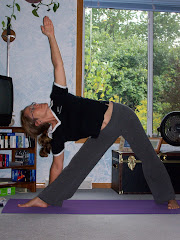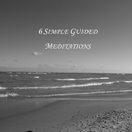
It seems that many students come in with similar questions or concerns. I'll be honest, I work on remembering everyones' names and faces. There's just no room in my brain for each ailment or health history as well. Not too mention the fact that in a group class to offer specific modifications for each person--back pain, arthritis, herniated cervical disc, SI issue, migraines, pregnant, manic, depressed, high blood pressure, low blood pressure... well, you get the idea--is close to impossible! So, over the years I've created a number of handouts for students that will hopefully empower them to make their own modifications, and understand their unique case and how it relates to Yoga.
I'd like to share my favorite one, covering Menopause and Yoga. Here it is:
During menopause, focus on cooling asanas (postures). The adrenals may be stressed causing irritability and anxiety. Backbends will help with fatigue and sleepiness. In general, a restorative practice is best at this time. A restorative practice involves staying in fully supported asanas for anywhere from 1 to 21 minutes. To see the most benefit, practice at least 3 times a week. However, once a week is better than not at all. For each practice, include at least 1 from the following groups. If time allows, add more. If at any time you experience discomfort, consult an experienced Yoga teacher to help with alignment and finding the proper support.
Centering – to calm the mind and bring awareness to the present moment
Centering – to calm the mind and bring awareness to the present moment
2-6 minutes: Take a comfortable seat and observe (without trying to change or judge) the breath. Notice it’s temperature, moisture, texture, speed, depth, etc.
2-6 minutes: Breath deeply into the belly, low chest, and upper chest. Inhale from belly upwards to collar bones, and exhale from collarbones down to belly. Breathe deep and steady throughout your entire practice.
Inversions – for the endocine system, increase blood to the brain, and soothe the mind
8-21 minutes: Supported Legs on wall. Place a few blankets at least 4” away from the wall. Lay w/ the sit bones between the blankets and the wall while the legs rest against the wall pointing toward the sky. If the hamstrings (back legs) feel tight, move the blankets and sit bones further away from the wall. The head and shoulders are lower than the hips.
8-21 minutes: Lay on your back with the lower body (legs and/or torso) on a stack of blankets anywhere from 3” to 6” high. Head and shoulders are off of the blanket(s). Play some soothing music and relax.
Backbends – aid the kidneys, nourish the adrenals, energize, and open the heart
1 minute: Lay on the belly. Clasp the hands behind the back or lay them on the back if you cannot reach to clasp. Keeping the legs strong and steady, on an inhale lift the heart center and head off the ground. Continue to breathe. When you are ready, come down slowly with an exhale. Do this 3 times. Your back must feel comfortable and without any pinching. See an instructor if you have trouble with this.
2-3 minutes: If you are an experienced Yogini, then take bow (dhanurasana) and supine hero (supta Virasana)
2-4 minutes: Lay on your back. Side body long and feet parallel and hip distance apart. Knees are bent. Push the feet into the ground and inhale to lift the hips off the earth. This is bridge (setu bandhasana) posture. You may do this as a restorative by placing a blanket or block under the sacrum and releasing into the support. Or you may make it more active, by clasping the hands under the body and lifting the heart with vibrancy. Hold while breathing and come down on an exhale.
5-25 minutes: Supported bound angle (supta baddha konasana). Create a stack of blankets into a wedge shape long enough to support your torso and head. Sit on the floor with your back to the bottom of the wedge. Lay back. Your torso should be at about a 45 degree angel from the floor. Make sure the neck and head are supported, as well. With bent knees, bring the feet and knees together—knees pointing to the sky. Now open the knees out to the sides, while the soles of the feet touch one another. Place a blanket, pillow, or foam blocks under the knees to ensure that the inner leg stretch is not too much. Lay the arms out to the sides and lower than shoulder height. Use blankets, pillows, or blocks to support the forearms. This will prevent too much strain on the neck and shoulder area. Place an eye pad or wash cloth over your eyes, maybe even play some soothing music, and enjoy!
Forward bends – release any tension from backbends and soothe the mind
1-3 minutes: Supported Head to Knee (Salamba Janu Sirsasana). Sit on the floor or on the edge of a blanket. Extend your left leg out straight and bend the right knee. Open the right knee out towards the floor with the right foot touching the inside of the straight left leg. Place a stack of blankets over the straight leg. Inhale as you lengthen the spine, then exhale and keeping a tall straight spine, twist to the left slightly and lay the torso on top of the blankets. Be careful to not strain the low back in this position. Switch sides.
1-3 minutes: Half plow (ardha halasana). Fold a blanket 2”-3” thick to support the shoulders. Lay on your back with the shoulders and upper back on the blanket and head and neck off of it. With feet on the ground, inhale and lift the hips. Slide the shoulder blades closer together and clasp the hands under your body. Push the arms down as you bring the legs over your head and support the feet on a chair. The neck and shoulders must not experience any strain or discomfort. If you have neck issues, shoulder issues, uncontrolled high blood pressure, or glaucoma, then do NOT do this posture (asana).
1-2 minutes: Standing forward bend (uttanasana). Stand with feet hip distance apart and parallel. On an exhale bend from the tops of the legs into a forward fold. If your hands do not reach the ground, then place them on blocks or a chair to support the surrender in the spine.
Breathing – too cool the body and mind
3-10 minutes: Take a comfortable seat and lengthen the torso. Either stick out your tongue (yes, I’m serious) and curl it (if you can), or gently bring the teeth together and open the lips apart. Inhale long and slow through the mouth without any strain whatsoever. Close the mouth (tongue inside to re-moisten) to exhale. Continue the inhales through the mouth and exhales through the nostrils. Bring all of your awareness to the breath. Be patient with a wandering mind and without judgment, draw the mind back to the breath whenever it wanders.
To being a woman!
Kris



No comments:
Post a Comment